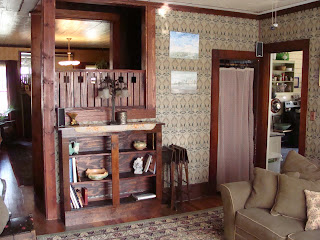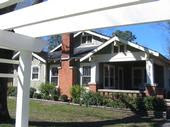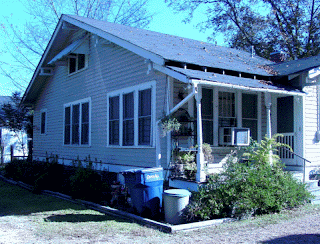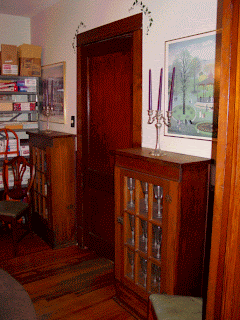

Figured I would start off this blog by going into

the trials and tribulations of wallpapering the old

fashion way. I explained a little last blog about the way a homes interior walls would have historically been treated,and with this post I wanted to show some pictures and go into some of the different things that we were surprised with along the way.
Note:The first couple pictures are of the room before we moved in, see if you can match the views up with the new (hint we found a fireplace under the sheetrock!). You will also see the opening of the staircase that is mentioned later.
After we had decided to rip down all the drywall put in late last century, we started in the room that we wanted to finish the most. At the heart of the house, the den was the room that we spent most of our time reading, watching tv or just sitting around talking about the days events. The plan was to make it warm and cozy, period appropriate but not to "museum like", and most of all ours! The current decorating was not exactly our style and the direction we wanted to go in would reflect our personalities but also show something that could have actually been seen in the 1920's.
 History lesson
History lessonLet me first say that the typical 1920's house in Central Mississippi would have been a bit out of trend with the rest of the country, as has been seen throughout most of history in the south. You see, the southern states not only fell a little behind in the times, but by choice most Southerners hate change. Now don't get me wrong, and please refrain from hate mail, I am not at all bashing the southern way of life! I am simply stating facts here! Most Southerners know what they like and need a little time to get use to something before they go all out and change it, Thats not something bad, just different from Northerners or East/West coasters.
Keeping this in mind we went with a wallpaper that had a bit of an English Arts and Crafts feel with a little bit of Art Nouveau.
Getting DirtyTearing the drywall was the cheap, and fun part of the project. Demo is always a good time, but make sure you have the proper equipment! Glasses and a dusk mask are a must, I usually don't like to wear gloves (its a machismo thing) but Julie has a good pair of contractor gloves that she got for about $20. You also will need a good pry bar, nail pullers, a flat and possibly Phillips screwdriver and a claw hammer. Depending on the lighting fixtures, wall plates and different aspects of construction, other tools may be needed as well but not usually anything major.
Once the drywall is off you will have to pull the drywall nails. If modern sheetrock was used it may have screws instead, which will slow you down a bit. As I had mentioned in my last post, the drywallers for our house went right over the existing wall finishes, which were a 1960's acoustical tile board and fortunately for us the original owners wallpapers. Most of the old paper we have dated to what seems to be a 1940's redecorating phase by Mrs. Young, however the paper in the kitchen had been doubled and the bottom layer appears to be a simple geometric pattern that we feel is original to the construction date.
Getting PrettyOnce the nails where pulled it was time to make the room pretty again. The look of the bare plank walls with great heart pine patina was very striking in itself, but gave the rooms a log cabin effect that we were not really going for.
The paper itself came from on online supplier as did the hangers canvas. Cost wise, the canvas is a much cheaper application. At about $.30 per square foot with the tacks it saves you not only time but the frustration level over hanging drywall and then mudding, sanding, mudding, sanding, mudding, sanding (you get the point). On top of that wallpapering over canvas is significantly easier because you don't have to worry about air bubbles (for obvious reasons, the canvas doesn't trap air). Depending on the paper you may need to use a liner paper, which will raise the cost a bit (about $.14 per sq.ft.), but will give you a much nicer finish. This will also help keep the corners square.
Starting at a corner tack one side of the canvas to the wall in a straight, vertical line. It is a good idea to leave about an inch extra that can be tucked into the gap in the corner. The tacks should be nailed about every 8 to 10 inches to keep the canvas taught but not wasteful of supplies. Once one side is complete, tack the top in the same manner. The opposite side can then be stretched and tacked in place, followed by the bottom. I have found that a line of tacks down the center of each sheet helps keep the canvas tight when the paper shrinks. The next sheet should be started over the last sheet by overlapping so that there is no exposed wood left. The paper will not stick to the lumbered walls, hence the reason for the hangers canvas in the first place, make sense? It does not matter which direction you go around the room, but I have found (being a right handed person) that starting with the left side makes it easier to pull the canvas tight as you nail.
Once the canvas is up you can paper just as you would any other surface. We have it down pretty well so that Julie can follow me around the room after I get about 2 sheets ahead of her with the canvas. To hang the paper you can either use a regular wallpaper paste that can be bought at most DIY stores, or opt for the authentic "wheat paste" that is available through the same online dealers that supply hangers canvas, tacks and liner papers. We went with the wheat paste, frankly because, as I had mentioned before...we are purists!(I highly suggest using a paste even with prepasted papers.)
To finish the ceiling we decided to forgo the wallpaper and simply paint the lap boards. To dress it up a little we designed a stencil that we have incorporated into different aspects of the homes design. A very simple but catching design I call a "4 square", you see it a lot in mission style furniture, light fixtures, and bronze work of the period.
Finishing TrimAfter the paper was up and allowed time to dry thoroughly, we then installed a crown molding that I had decided upon. The usual store bought pre-formed profile molding just wouldn't do for a true craftsman, so we made our own. Now, don't get the idea that I have all sorts of tools (well, actually, I do...but I didn't NEED them), the old school way of any molding project is by fitting different pieces together to get the profile you want. I choose a profile that I found in a 1920's Morgan Home Builders catalog that incorporated three different pieces (a 1x6 cut in half and laid perpendicular to each other and then a piece of cove molding). It looks great stained or painted, and best of all it is the same style as what originally COULD have been in the house!
With the room papered and the trim installed, it really gives quite a different feel. And if we get tired of it, we can easily rip it down and do it again. The paper and hangers canvas will come off in whole panels, unlike paper on sheetrock, which is another great benefit if this method.
Note: with this type of wall construction and finish technique you will see wrinkles in the paper after a few days of steady rain or moisture in the air, don't worry when the sun comes back out, the paper will shrink and smooth back to normal. You may find this disturbing but I call it character!! A steadily conditioned home with ample insulation in the walls may not have this problem... I wouldn't know:).


.JPG)




































